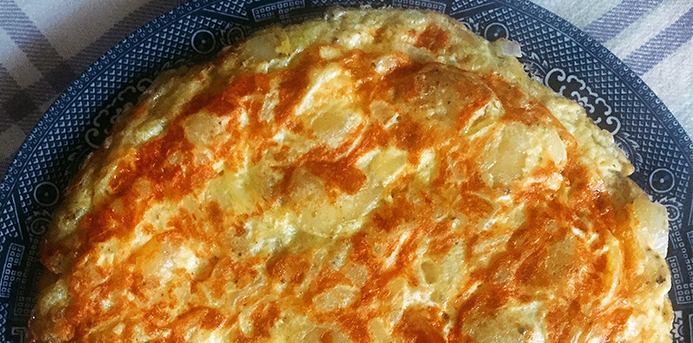Mid-September, at Maple & Ash in Chicago, we were at a dinner celebrating the release of a new book, “Coming to My Senses” by Alice Waters of Berkeley’s legendary Chez Panisse. Of her experiences with the Spanish tortilla, Waters said, “The first time I had one in Spain, when I was a teenager, I was so surprised because I was expecting a cornmeal tortilla.”
Waters’ youthful mistake is understandable. In this part of North America, we understand the tortilla to be Mexico’s flat cornmeal disk. In Spain, it’s a kind of “little cake” made with three everyday ingredients: eggs, potatoes and onions. The Spanish tortilla is tender, almost fluffy, sometimes very gently browned on the outside. This tortilla of Spain is served in slices, either hot or at room temperature, for any meal of the day, classically accompanied by crusty bread, a green salad, and a glass of wine.
How to Make It

Here’s how you make a Spanish tortilla. The recipe is loose, allowing for varying amounts of egg, potato and onion, as well as some olive oil, salt and pepper. The only tools you’ll need are a non-stick pan with sloped sides, a rubber spatula and a plate (and, as you’ll see below, perhaps a flat pan lid with a handle).
1. Gather a few eggs, five will do, though you may use more; you want enough eggs in the pan to give the tortilla some height. Beat the eggs well, and add pepper and a pinch of salt, which helps the eggs retain moisture. Some think salting eggs will make them tough; food scientist Harold McGee, however, has written in his magisterial “On Food and Cooking” that salt makes “eggs thicken and coagulate at a lower temperature … and actually produces a more tender texture.”
2. Peel and slice about five or more white potatoes; over medium heat, pan-fry the potato slices in olive oil; when they’re soft, remove them from the heat. Mark Mendez, formerly of Carnivale and Vera and currently at Arbor, told us to “think of the tortilla as a potato dish with eggs, not an egg dish with potatoes; there should be a lot of potatoes.”
3. Peel and slice about two medium yellow onions; pan-fry in medium heat, being careful not to brown; when they’re soft, remove from the heat. Onions have been used in every tortilla we’ve had, though Chef Marcos Campos of Black Bull and Beatnik explains that “In Spain there’s a ‘big fight’ about using onions or not in the recipe, but I have to say I’m part of the people who love onions in the tortilla.” We are too.

4. Pour the cooked potatoes and onions into the egg mixture and allow it all to sit for a few minutes.
5. In a non-stick pan with sloped sides, over medium heat, add a good amount of oil and warm it up; then pour in the mixture of eggs, potatoes and onions. About oil, Ashlee Aubin of Salero and Wood cautions that oftentimes when making tortillas, “people don’t use enough olive oil … so use a lot of good olive oil.”

6. As the mixture begins to harden in the heat, gently run the rubber spatula around the inside edges of the pan to free up the sides of the cooking mixture; gently jiggle the pan now and again to keep things loose.
7. When the mixture is cooked about halfway through, you’ll need to flip it to the other side. This can be challenging. Traditional Spanish cooks place a large plate on top of the pan and carefully flip the pan so that the uncooked side of the tortilla is on the plate. Then you slide the tortilla back into the pan to finish cooking. Instead of a plate, we use a flat pan lid with a handle, which gives you more control as you maneuver the half-cooked tortilla onto the lid and back into the pan.
8. Once the mixture has been flipped, heat slightly if you want the eggs runny; heat a little more to cook all the way though. Says Mendez, “I don’t cook it very much on the second side; overcooking the eggs tends to dry out the tortilla quite a bit.” Aubin adds that “the key is to get the inside just barely set to custardy perfection.”
9. Slide the tortilla onto a plate and serve.
“I’m in love with the tortilla since I was a kid,” says Campos. “Now I need to have it on all my menus in the different restaurants I work; at Beatnik, we serve it for brunch topped with fresh uni and trout roe for a different and funny version of the classic.”
As with any classic preparation, accomplished chefs will want to put their stamp upon the tortilla, innovating upon the traditional platform to make something new. That’s all good because foods change over time, no recipe is written in stone, and improvements are always, at least theoretically, possible. The traditional tortilla, however, is so pure and so elemental that, for many, it pleases not by its inventiveness but by its perfectly satisfying simplicity. The classic Spanish tortilla, like a classic cocktail, is created from just three ingredients, and when properly prepared, it’s almost as intoxicating.
The Cousins of Spanish Tortilla: Omelette and Frittata
A Spanish tortilla is not an omelette, though it’s sometimes called, misleadingly, a Spanish omelette. Unlike a traditional omelette, a Spanish tortilla is not folded over, and it’s not filled with cheese or anything else. It’s just the eggs, potatoes and onions.
A Spanish tortilla is not a frittata, which usually contains cheese, vegetables, even pasta. A frittata is not flipped and it’s usually finished in the oven or under a broiler. A frittata is sometimes called a crust-less quiche, and it may be that, but a Spanish tortilla is neither a frittata nor a quiche.
Broaden Your Food Horizons
We believe food is one of life’s great connectors, bringing people together in so many impactful ways: Families share important bonding time over nightly meals at home, philanthropists accomplish critical fundraising over gala dinners, deals are done and ideas are sparked over business lunches, and we broaden our cultural awareness of the world in all of its beautiful diversity when we learn about food from different countries and cultures. If you’ve never had a Spanish tortilla, we hope you’ll try it, love it, then explore other new foods from around the globe. You can start by visiting some of Chicago’s great international food markets.
More from Make It Better:
- The 12 Best Pizzas to Try in Chicago Right Now
- Rise and Shine! Great Breakfast Spots in Chicago
- Must Be Chocolate Gives Back With The Chicagoland Holiday Chocolate Show

David Hammond is Dining and Drinking Editor at Newcity and contributes to the Chicago Tribune and other publications. In 2004, he co-founded LTHForum.com, the 15,000 member food chat site; for several years he wrote weekly “Food Detective” columns in the Chicago Sun-Times; he writes weekly food columns for Wednesday Journal. He has written extensively about the culinary traditions of Mexico and Southeast Asia and contributed several chapters to “Street Food Around the World.”
David is a supporter of S.A.C.R.E.D., Saving Agave for Culture, Recreation, Education and Development, an organization founded by Chicagoan Lou Bank and dedicated to increasing awareness of agave distillates and ensuring that the benefits of that awareness flow to the villages of Oaxaca, Mexico. Currently, S.A.C.R.E.D is funding the development of agave farms, a library and water preservation systems for the community of Santa Catarina Minas, Oaxaca.

